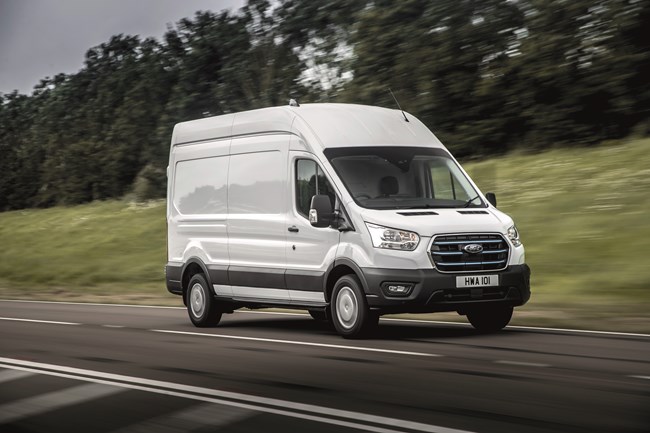- New Maxus EVs include eDeliver 5 van
- Used LCV values reach six-month high
- ADVERTISEMENT FEATURE: IVECO Daily Mission Awards 2024 Q2 Round-up: Grounds Maintenance & Forestry
- Stellantis Pro One electric vans review
- Mitie adds 5,000th EV to fleet
- Record number of CVs now on UK roads, SMMT reports
- Tyres: The path of least resistance
- ETRUX receives Ford Pro Convertor status
- The Logistics Organisation adds to van fleet with Vanaways
- Northgate launches micromobility service
New Market Analysis: Large Vans
Date: Monday, February 21, 2022 | Author: James Dallas
Ford has taken its time going electric but its E-Transit is set to make a big splash in the large van sector.

Demand from the home delivery and construction markets drove up sales of vans weighing between 2.5 and 3.5t, the sector containing large vans, by 28% to almost 244,000 units last year, according to the Society of motor Manufacturers and Traders (SMMT).
Two large vans featured in the top ten sellers list for 2021, the Ford Transit was the UK’s second biggest seller of the year with 34,293 registrations ahead of the Mercedes Sprinter in third place with 21,915 sales.
The biggest news in the large van sector in 2022 will almost certainly be the arrival in March of Ford’s long-awaited E-Transit.
Ford is coming late to the electric van party but the strength of the Transit brand name coupled with the breadth of the range means the E-Transit will be a force to be reckoned with.
It has a claimed range of 196 miles from its 68kWh battery and its £42,000 (excluding VAT and the PiVG) starting price significantly undercuts its rivals. Mercedes’ eSprinter, for example, starts from £51,950, excluding VAT and the PiVG.
The E-Transit is powered by a 198kW electric motor producing up to 265hp and 430Nm of torque but will also be available with a toned down 135kW, 181hp motor.
It will launch with 25 variants, including short-, medium- and long-wheelbases panel vans with two roof heights. There’ll also be three different gross vehicle weights, offering the E-Transit van at 3.5t, 3.9t or 4.25t, giving a maximum payload of up to 1,758kg for the panel van models and 2,090kg for a chassis cab.
Late last year, Renault previewed two new versions of its large van, the Master E-Tech Electric, and the Master chassis cab H2-Tech prototype. The Master E-Tech Electric features a 52kWh battery, meaning an expected 121-mile range on the WLTP cycle. As for the H2-Tech prototype, it features hydrogen technology, offering an expected range of around 155 miles, and allows for bespoke conversions, with capacity for loads up to 19m3.
Rival French manufacturer Citroen announced updates to its Relay large van in the fourth quarter of last year.
Among changes are the introduction of two new 2.2l Euro 6.3-compliant diesel engines, producing 120hp and 140hp, which Citroen says produce up to 9g/km less CO2than the outgoing engines they replace.
Upgrades to standard spec have also been introduced, with extra equipment with the entry-level X trim level including cruise control with programmable speed limiter, a load area 12V socket, and an alarm and deadlocks.
Higher-spec Enterprise and Driver models gain a USB charging socket on the dashboard, and a tablet computer holder. The latter doesn’t apply to window van versions, but they instead gain a lower central glovebox and electrical connections interface box. Prices for the line-up, excluding VAT, start at £26,655.
Finally, veterinary supplier Covetrus has taken on 34 long-wheelbase Volkswagen Crafter vans converted to its specifications by Coolkit. The majority of the load space is run at the controlled ambient temperatures required while Coolkit has also instaled a separate, smaller container for the chilled goods.
Timeline
Citroen Relay update October 2021
Ford E-Transit March 2022
Renault Master E-Tech Electric March 2022
Renault Master chassis cab H2-tech (est) October 2022
View The WhatVan Digital Edition


